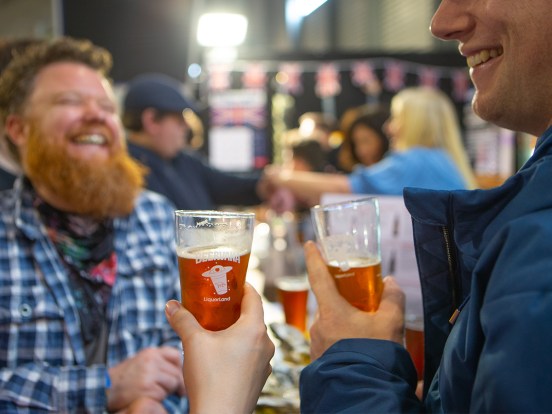With epic changes happening in the beverage alcohol industry in 2020, market analysts IWSR have shared the trends and market forces that will drive the liquor industry over the coming year.
Channel shifts and the impact of ecommerce on on- and off- channel splits
COVID-19 lockdowns and the subsequent rise of the at-home drinking occasion forced many brand owners to shift channel investment into ecommerce by necessity.
In fact, the value of the ecommerce market in 10 core countries grew by an estimated 40% in 2020, according to IWSR data.
Consumers have now become increasingly comfortable with purchasing alcohol online: IWSR data shows that in the US, for example, 44% of alcohol e-shoppers only started buying alcohol online in 2020, compared to 19% in 2019.
As we move into 2021, channel shifts will continue to evolve. Ecommerce will remain a critical investment, and going forward, will require a nuanced strategy that’s coordinated globally but deployed locally, taking local laws into consideration.
As at-home consumption increasingly becomes an occasion in itself, brand owners will need to re-evaluate their balance of investments between bricks & mortar and on-premise channel splits.
Plans will need to be adapted to take into account a smaller on-trade sector, which is especially important for product activation strategies.
Brand owners will need to take a more nuanced approach to premiumisation
The pandemic has had a nuanced impact on premiumisation trends, and going into 2021, brand owners will need to apply a more considered approach to premiumisation strategies, dependent on country, channel, category and demographic combinations. We will likely see three price trends moving forward:
• Premiumisation continues: Despite the impact of COVID-19, some consumers, especially those in developed markets, would have benefitted financially from lockdowns, where spend on commuting, social activities or holidays would have decreased. Premiumisation trends will continue in some categories and markets, such as for agave-based spirits in the US and blended Scotch in the UK.
• Return to tried and trusted: Some consumers will return to well-known brands and avoid experimentation or high-level spending. In some cases, this may be a result of changes in the bricks-and-mortar experience, where social distancing restrictions or personal preferences may make consumers less inclined to browse in shop aisles. This pricing trend will likely be apparent in categories such as rum in France and still wine in Japan.
• Democratisation or downtrading: Countries hard-hit by the economic impact of COVID-19 will likely see more consumers opting to down-trade as they focus on value-for-money options. Limited furlough schemes or a higher level of personal taxation may create longer-term income pressures for consumers in both less developed as well as developed countries.
Changes in leadership, diplomatic relationships and legislation come into focus
• New leadership in the US brings former policies of protectionism into focus, and is raising key questions, such as whether the new administration will review beverage alcohol import duties, or how tariffs imposed by the US may differ between the UK and the EU.
• Changes in global relationships with China and shifts in trade policies, such as those on Australian wine exports, will continue to impact the global industry landscape.
• Post-Brexit discussions will be key for arrangements within Europe. Industry stakeholders will be paying close attention, for example, to developments that could impact trade flows, as well as future EU laws on alcohol ingredients labelling, which would impact the Scotch industry in particular.
• Governments may also review legislation on beverage alcohol ecommerce – for instance, a liberalisation of currently restrictive ecommerce regulations in large markets such as Russia or India could have a significant impact on route-to-market.
The trend for convenience and the evolution of the global ready-to-drink (RTD) category
The ready-to-drink (RTD) alcohol category, which includes hard seltzers, flavoured alcohol beverages, and pre-mixed cocktails, is under rapid transformation across leading markets, with volume growth out-pacing that of other beverage alcohol categories globally.
While there are distinct differences across all countries, it’s clear that hard seltzers or seltzer-like products are growing in popularity as consumers look for sessionable, lower-ABV options.
The portability and single-serve nature of RTDs has proven a key factor of growth, especially during COVID-19. Convenience is a key tenet of go-to-market & channel distribution strategies, especially in countries such as Japan, the US, Mexico and Brazil.
Between 2019 and 2020, consumers in 10 key RTD markets gained close to 2000 new RTD products.
Throughout 2021, category evolution will be driven by factors such as innovation in alcohol bases, exploration of new and increasingly local flavours, and premium product offerings.
RTD brands that are seeking cross-border development will need to pay close attention to taxation rules for varying alcohol bases, which differ between countries.
No- and low-alcohol offerings become aspirational
2020 cemented the no- and low-alcohol category as a mainstay in consumers’ drinking repertoires, with COVID-19 prompting key changes in consumer attitudes, driven by the at-home occasion and an increased awareness of health and wellness.
IWSR research shows that across key no- and low-alcohol markets, relaxing at home represents the category’s key drinking occasion.
These consumer attitudes are set to continue into 2021. Where no- and low-alcohol offerings were once almost stigmatised, the category has now become aspirational, with consumers increasingly willing to pay a premium for no- and low-alcohol products.
IWSR data shows that while most markets are expecting to see elements of growth within the no/low segment, key growth markets include the US, Germany and Spain, largely driven by the expansion of no- and low-alcohol beer and wine. Within the no/low spirits category, the US and UK will see some of the most rapid growth.
Did you know?
There are 6 ways you can catch up with The Shout NZ?
Our print magazine – February issue out soon! Subscribe here.
Online, updated daily with its own completely unique content and breaking news.
Our weekly newsletter – free to your inbox! Subscribe here.
Our digital magazines – the latest issues are online now.
We are also on Facebook and Instagram!




